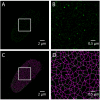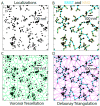Quantitative Analysis of Nuclear Lamins Imaged by Super-Resolution Light Microscopy
- PMID: 31003483
- PMCID: PMC6524165
- DOI: 10.3390/cells8040361
Quantitative Analysis of Nuclear Lamins Imaged by Super-Resolution Light Microscopy
Abstract
The nuclear lamina consists of a dense fibrous meshwork of nuclear lamins, Type V intermediate filaments, and is ~14 nm thick according to recent cryo-electron tomography studies. Recent advances in light microscopy have extended the resolution to a scale allowing for the fine structure of the lamina to be imaged in the context of the whole nucleus. We review quantitative approaches to analyze the imaging data of the nuclear lamina as acquired by structured illumination microscopy (SIM) and single molecule localization microscopy (SMLM), as well as the requisite cell preparation techniques. In particular, we discuss the application of steerable filters and graph-based methods to segment the structure of the four mammalian lamin isoforms (A, C, B1, and B2) and extract quantitative information.
Keywords: computational geometry; delaunay triangulation; lamins; single molecule localization microscopy; steerable filters; structured illumination microscopy; voronoi tessellation.
Conflict of interest statement
The authors declare no conflict of interest. The funders had no role in the design the study; in the collection, analyses, or interpretation of the data; in the writing of the manuscript, or in the decision to publish the results.
Figures







Similar articles
-
The molecular architecture of lamins in somatic cells.Nature. 2017 Mar 9;543(7644):261-264. doi: 10.1038/nature21382. Epub 2017 Mar 1. Nature. 2017. PMID: 28241138 Free PMC article.
-
Nonlinear mechanics of lamin filaments and the meshwork topology build an emergent nuclear lamina.Nat Commun. 2020 Dec 4;11(1):6205. doi: 10.1038/s41467-020-20049-8. Nat Commun. 2020. PMID: 33277502 Free PMC article.
-
Structural and physiological phenotypes of disease-linked lamin mutations in C. elegans.J Struct Biol. 2012 Jan;177(1):106-12. doi: 10.1016/j.jsb.2011.10.009. Epub 2011 Nov 7. J Struct Biol. 2012. PMID: 22079399
-
Lamins: The backbone of the nucleocytoskeleton interface.Curr Opin Cell Biol. 2024 Feb;86:102313. doi: 10.1016/j.ceb.2023.102313. Epub 2024 Jan 22. Curr Opin Cell Biol. 2024. PMID: 38262116 Review.
-
The structure of lamin filaments in somatic cells as revealed by cryo-electron tomography.Nucleus. 2017 Sep 3;8(5):475-481. doi: 10.1080/19491034.2017.1337622. Epub 2017 Jun 21. Nucleus. 2017. PMID: 28635493 Free PMC article. Review.
Cited by
-
Lamina-associated domains: peripheral matters and internal affairs.Genome Biol. 2020 Apr 2;21(1):85. doi: 10.1186/s13059-020-02003-5. Genome Biol. 2020. PMID: 32241294 Free PMC article. Review.
-
Super-Resolution Imaging of the A- and B-Type Lamin Networks: A Comparative Study of Different Fluorescence Labeling Procedures.Int J Mol Sci. 2021 Sep 22;22(19):10194. doi: 10.3390/ijms221910194. Int J Mol Sci. 2021. PMID: 34638534 Free PMC article.
-
Modeling of Cell Nuclear Mechanics: Classes, Components, and Applications.Cells. 2020 Jul 6;9(7):1623. doi: 10.3390/cells9071623. Cells. 2020. PMID: 32640571 Free PMC article. Review.
-
A comprehensive method to study the DNA's association with lamin and chromatin compaction in intact cell nuclei at super resolution.Nanoscale. 2023 Jan 5;15(2):742-756. doi: 10.1039/d2nr02684h. Nanoscale. 2023. PMID: 36524744 Free PMC article.
-
Interplay of the nuclear envelope with chromatin in physiology and pathology.Nucleus. 2020 Dec;11(1):205-218. doi: 10.1080/19491034.2020.1806661. Nucleus. 2020. PMID: 32835589 Free PMC article. Review.
References
Publication types
MeSH terms
Substances
Grants and funding
LinkOut - more resources
Full Text Sources

